Analysis of Supermarket Chain: Key Operations and Strategies
VerifiedAdded on 2023/01/23
|7
|1414
|32
Report
AI Summary
This report examines the operational structure of a supermarket chain, highlighting key departments and their functions. It begins with an introduction to chain stores and the impact of technology, particularly e-commerce, on their success. The report then delves into supplier management, emphasizing the selection process, contract management, and price determination. Warehouse and logistics considerations, including location, workforce availability, and longevity, are also discussed. The role of local stores, customer management, and group functions such as accounting, HR, and risk management are analyzed. A significant portion focuses on IT operations, its integration across departments, and its benefits. The report concludes with recommendations for embracing e-commerce and references supporting literature.

Running Head: REPORT
REPORT
Insert Your Name Here
Insert Your Tutor’s Name Here
Institution Affiliation
Date
REPORT
Insert Your Name Here
Insert Your Tutor’s Name Here
Institution Affiliation
Date
Paraphrase This Document
Need a fresh take? Get an instant paraphrase of this document with our AI Paraphraser
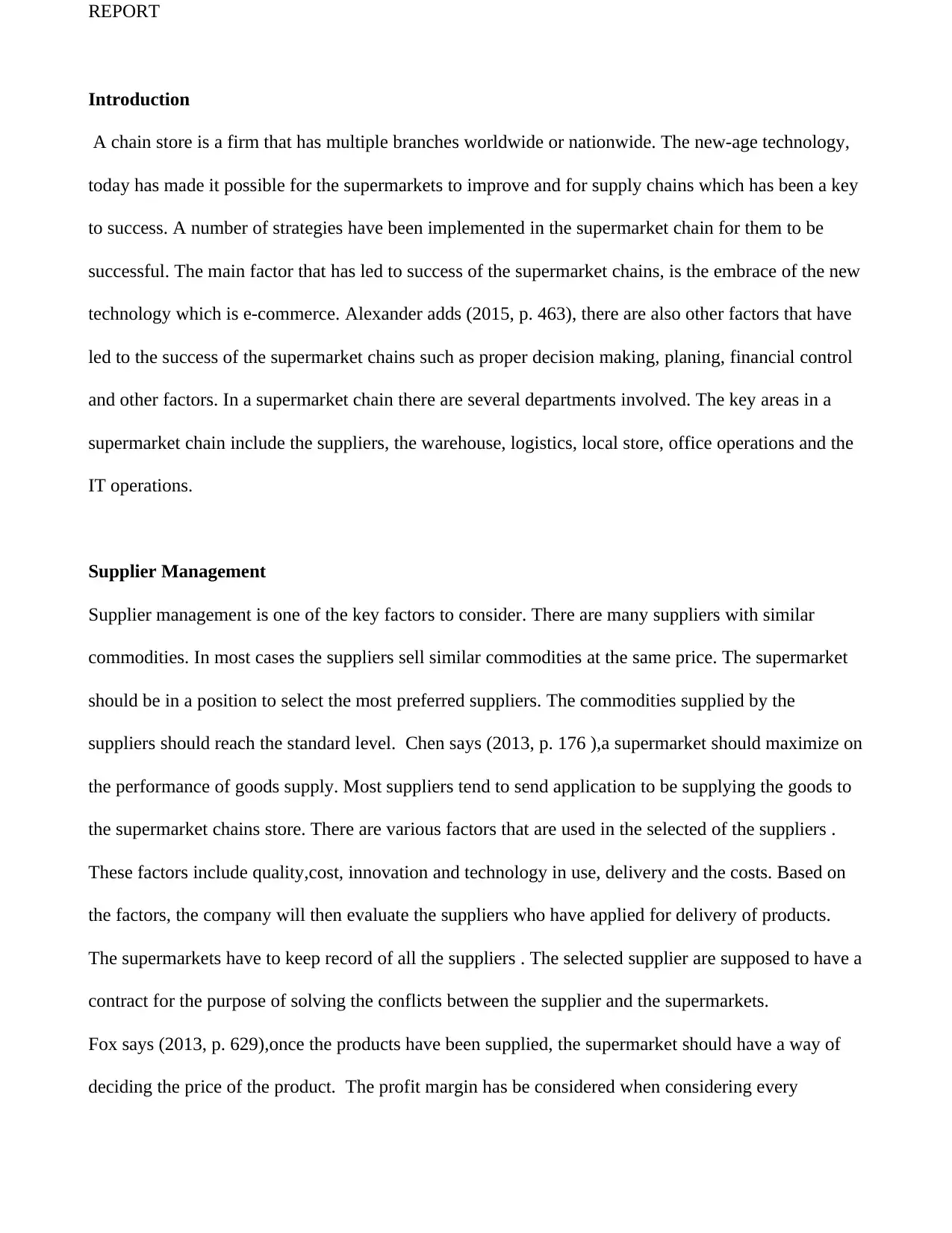
REPORT
Introduction
A chain store is a firm that has multiple branches worldwide or nationwide. The new-age technology,
today has made it possible for the supermarkets to improve and for supply chains which has been a key
to success. A number of strategies have been implemented in the supermarket chain for them to be
successful. The main factor that has led to success of the supermarket chains, is the embrace of the new
technology which is e-commerce. Alexander adds (2015, p. 463), there are also other factors that have
led to the success of the supermarket chains such as proper decision making, planing, financial control
and other factors. In a supermarket chain there are several departments involved. The key areas in a
supermarket chain include the suppliers, the warehouse, logistics, local store, office operations and the
IT operations.
Supplier Management
Supplier management is one of the key factors to consider. There are many suppliers with similar
commodities. In most cases the suppliers sell similar commodities at the same price. The supermarket
should be in a position to select the most preferred suppliers. The commodities supplied by the
suppliers should reach the standard level. Chen says (2013, p. 176 ),a supermarket should maximize on
the performance of goods supply. Most suppliers tend to send application to be supplying the goods to
the supermarket chains store. There are various factors that are used in the selected of the suppliers .
These factors include quality,cost, innovation and technology in use, delivery and the costs. Based on
the factors, the company will then evaluate the suppliers who have applied for delivery of products.
The supermarkets have to keep record of all the suppliers . The selected supplier are supposed to have a
contract for the purpose of solving the conflicts between the supplier and the supermarkets.
Fox says (2013, p. 629),once the products have been supplied, the supermarket should have a way of
deciding the price of the product. The profit margin has be considered when considering every
Introduction
A chain store is a firm that has multiple branches worldwide or nationwide. The new-age technology,
today has made it possible for the supermarkets to improve and for supply chains which has been a key
to success. A number of strategies have been implemented in the supermarket chain for them to be
successful. The main factor that has led to success of the supermarket chains, is the embrace of the new
technology which is e-commerce. Alexander adds (2015, p. 463), there are also other factors that have
led to the success of the supermarket chains such as proper decision making, planing, financial control
and other factors. In a supermarket chain there are several departments involved. The key areas in a
supermarket chain include the suppliers, the warehouse, logistics, local store, office operations and the
IT operations.
Supplier Management
Supplier management is one of the key factors to consider. There are many suppliers with similar
commodities. In most cases the suppliers sell similar commodities at the same price. The supermarket
should be in a position to select the most preferred suppliers. The commodities supplied by the
suppliers should reach the standard level. Chen says (2013, p. 176 ),a supermarket should maximize on
the performance of goods supply. Most suppliers tend to send application to be supplying the goods to
the supermarket chains store. There are various factors that are used in the selected of the suppliers .
These factors include quality,cost, innovation and technology in use, delivery and the costs. Based on
the factors, the company will then evaluate the suppliers who have applied for delivery of products.
The supermarkets have to keep record of all the suppliers . The selected supplier are supposed to have a
contract for the purpose of solving the conflicts between the supplier and the supermarkets.
Fox says (2013, p. 629),once the products have been supplied, the supermarket should have a way of
deciding the price of the product. The profit margin has be considered when considering every
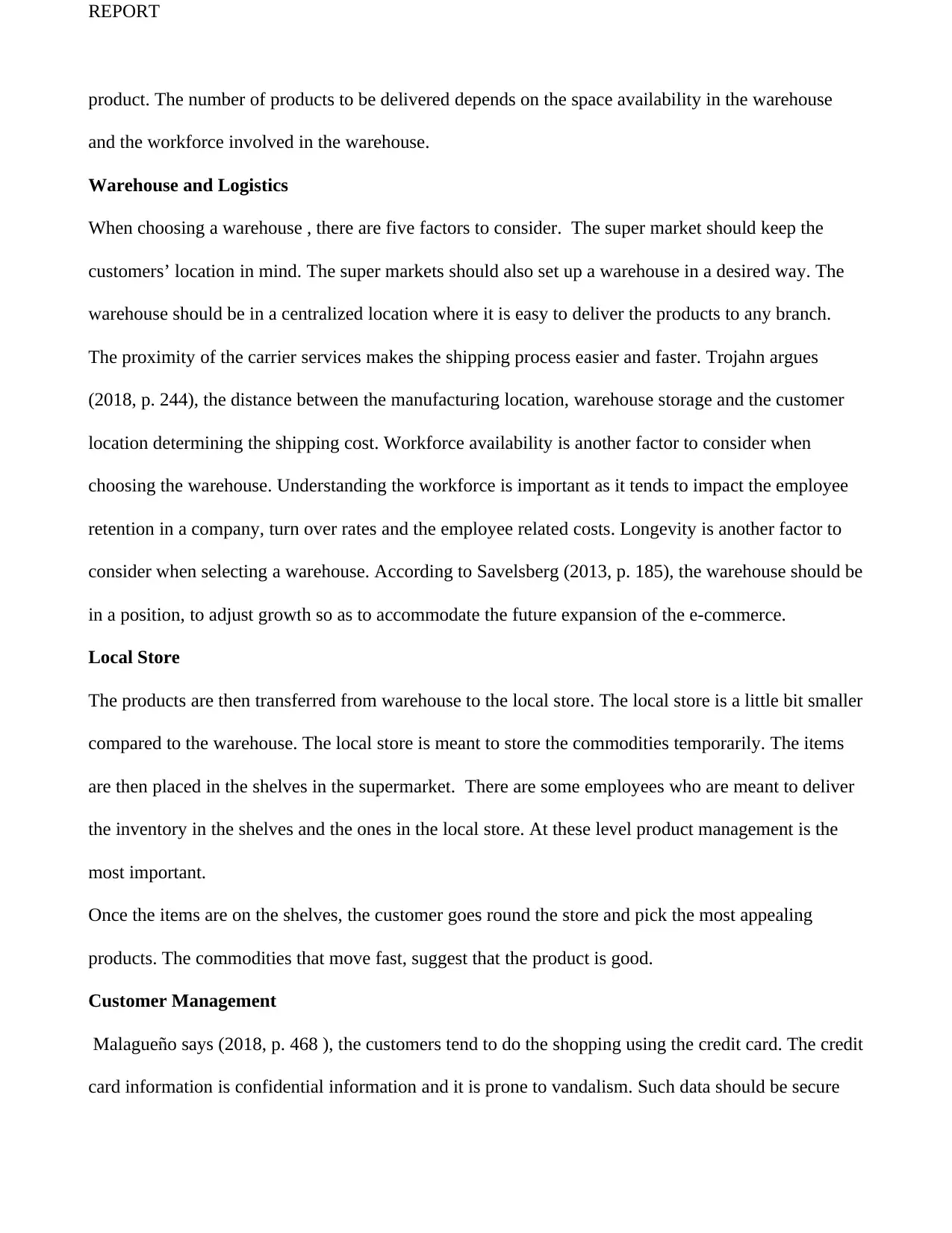
REPORT
product. The number of products to be delivered depends on the space availability in the warehouse
and the workforce involved in the warehouse.
Warehouse and Logistics
When choosing a warehouse , there are five factors to consider. The super market should keep the
customers’ location in mind. The super markets should also set up a warehouse in a desired way. The
warehouse should be in a centralized location where it is easy to deliver the products to any branch.
The proximity of the carrier services makes the shipping process easier and faster. Trojahn argues
(2018, p. 244), the distance between the manufacturing location, warehouse storage and the customer
location determining the shipping cost. Workforce availability is another factor to consider when
choosing the warehouse. Understanding the workforce is important as it tends to impact the employee
retention in a company, turn over rates and the employee related costs. Longevity is another factor to
consider when selecting a warehouse. According to Savelsberg (2013, p. 185), the warehouse should be
in a position, to adjust growth so as to accommodate the future expansion of the e-commerce.
Local Store
The products are then transferred from warehouse to the local store. The local store is a little bit smaller
compared to the warehouse. The local store is meant to store the commodities temporarily. The items
are then placed in the shelves in the supermarket. There are some employees who are meant to deliver
the inventory in the shelves and the ones in the local store. At these level product management is the
most important.
Once the items are on the shelves, the customer goes round the store and pick the most appealing
products. The commodities that move fast, suggest that the product is good.
Customer Management
Malagueño says (2018, p. 468 ), the customers tend to do the shopping using the credit card. The credit
card information is confidential information and it is prone to vandalism. Such data should be secure
product. The number of products to be delivered depends on the space availability in the warehouse
and the workforce involved in the warehouse.
Warehouse and Logistics
When choosing a warehouse , there are five factors to consider. The super market should keep the
customers’ location in mind. The super markets should also set up a warehouse in a desired way. The
warehouse should be in a centralized location where it is easy to deliver the products to any branch.
The proximity of the carrier services makes the shipping process easier and faster. Trojahn argues
(2018, p. 244), the distance between the manufacturing location, warehouse storage and the customer
location determining the shipping cost. Workforce availability is another factor to consider when
choosing the warehouse. Understanding the workforce is important as it tends to impact the employee
retention in a company, turn over rates and the employee related costs. Longevity is another factor to
consider when selecting a warehouse. According to Savelsberg (2013, p. 185), the warehouse should be
in a position, to adjust growth so as to accommodate the future expansion of the e-commerce.
Local Store
The products are then transferred from warehouse to the local store. The local store is a little bit smaller
compared to the warehouse. The local store is meant to store the commodities temporarily. The items
are then placed in the shelves in the supermarket. There are some employees who are meant to deliver
the inventory in the shelves and the ones in the local store. At these level product management is the
most important.
Once the items are on the shelves, the customer goes round the store and pick the most appealing
products. The commodities that move fast, suggest that the product is good.
Customer Management
Malagueño says (2018, p. 468 ), the customers tend to do the shopping using the credit card. The credit
card information is confidential information and it is prone to vandalism. Such data should be secure
⊘ This is a preview!⊘
Do you want full access?
Subscribe today to unlock all pages.

Trusted by 1+ million students worldwide
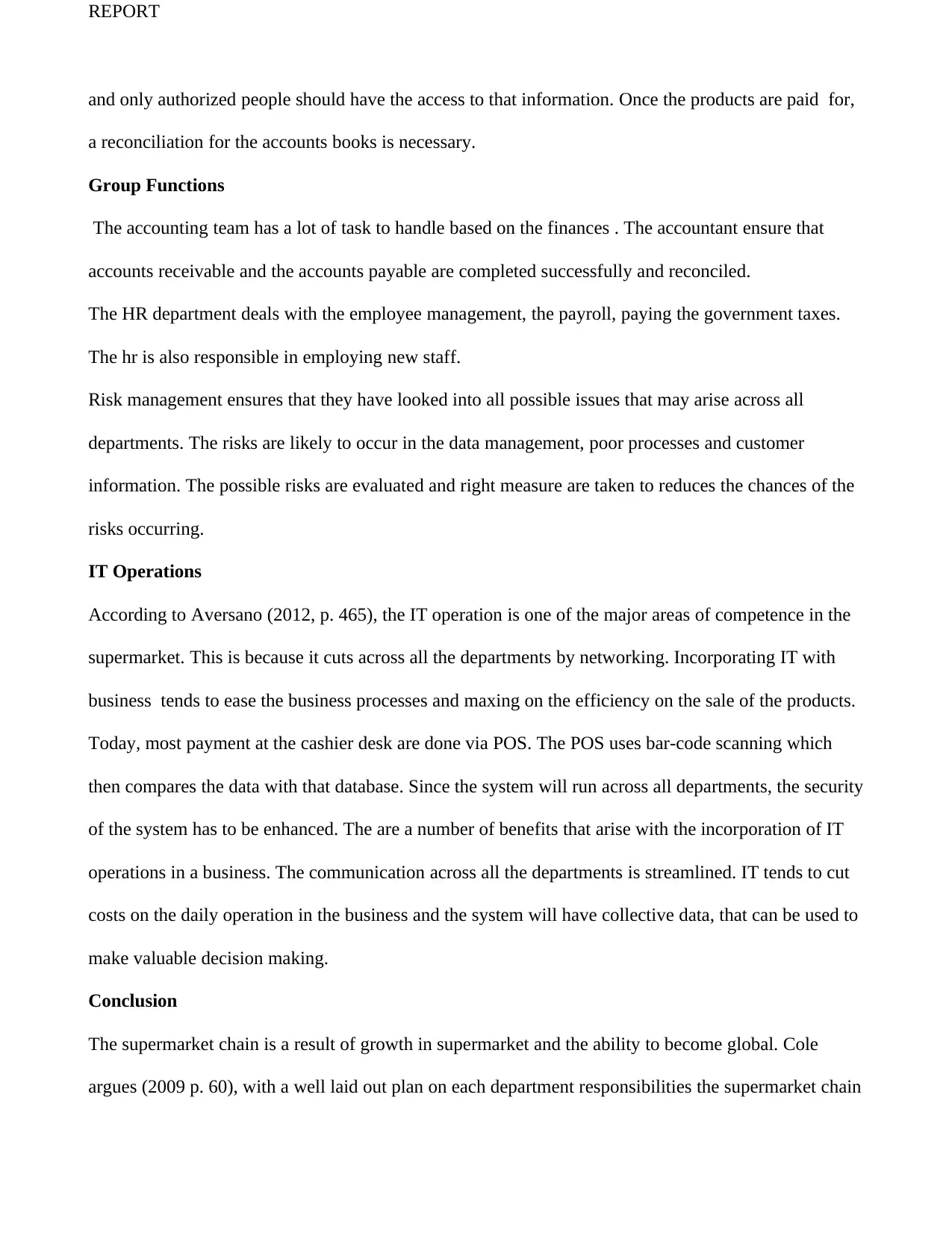
REPORT
and only authorized people should have the access to that information. Once the products are paid for,
a reconciliation for the accounts books is necessary.
Group Functions
The accounting team has a lot of task to handle based on the finances . The accountant ensure that
accounts receivable and the accounts payable are completed successfully and reconciled.
The HR department deals with the employee management, the payroll, paying the government taxes.
The hr is also responsible in employing new staff.
Risk management ensures that they have looked into all possible issues that may arise across all
departments. The risks are likely to occur in the data management, poor processes and customer
information. The possible risks are evaluated and right measure are taken to reduces the chances of the
risks occurring.
IT Operations
According to Aversano (2012, p. 465), the IT operation is one of the major areas of competence in the
supermarket. This is because it cuts across all the departments by networking. Incorporating IT with
business tends to ease the business processes and maxing on the efficiency on the sale of the products.
Today, most payment at the cashier desk are done via POS. The POS uses bar-code scanning which
then compares the data with that database. Since the system will run across all departments, the security
of the system has to be enhanced. The are a number of benefits that arise with the incorporation of IT
operations in a business. The communication across all the departments is streamlined. IT tends to cut
costs on the daily operation in the business and the system will have collective data, that can be used to
make valuable decision making.
Conclusion
The supermarket chain is a result of growth in supermarket and the ability to become global. Cole
argues (2009 p. 60), with a well laid out plan on each department responsibilities the supermarket chain
and only authorized people should have the access to that information. Once the products are paid for,
a reconciliation for the accounts books is necessary.
Group Functions
The accounting team has a lot of task to handle based on the finances . The accountant ensure that
accounts receivable and the accounts payable are completed successfully and reconciled.
The HR department deals with the employee management, the payroll, paying the government taxes.
The hr is also responsible in employing new staff.
Risk management ensures that they have looked into all possible issues that may arise across all
departments. The risks are likely to occur in the data management, poor processes and customer
information. The possible risks are evaluated and right measure are taken to reduces the chances of the
risks occurring.
IT Operations
According to Aversano (2012, p. 465), the IT operation is one of the major areas of competence in the
supermarket. This is because it cuts across all the departments by networking. Incorporating IT with
business tends to ease the business processes and maxing on the efficiency on the sale of the products.
Today, most payment at the cashier desk are done via POS. The POS uses bar-code scanning which
then compares the data with that database. Since the system will run across all departments, the security
of the system has to be enhanced. The are a number of benefits that arise with the incorporation of IT
operations in a business. The communication across all the departments is streamlined. IT tends to cut
costs on the daily operation in the business and the system will have collective data, that can be used to
make valuable decision making.
Conclusion
The supermarket chain is a result of growth in supermarket and the ability to become global. Cole
argues (2009 p. 60), with a well laid out plan on each department responsibilities the supermarket chain
Paraphrase This Document
Need a fresh take? Get an instant paraphrase of this document with our AI Paraphraser
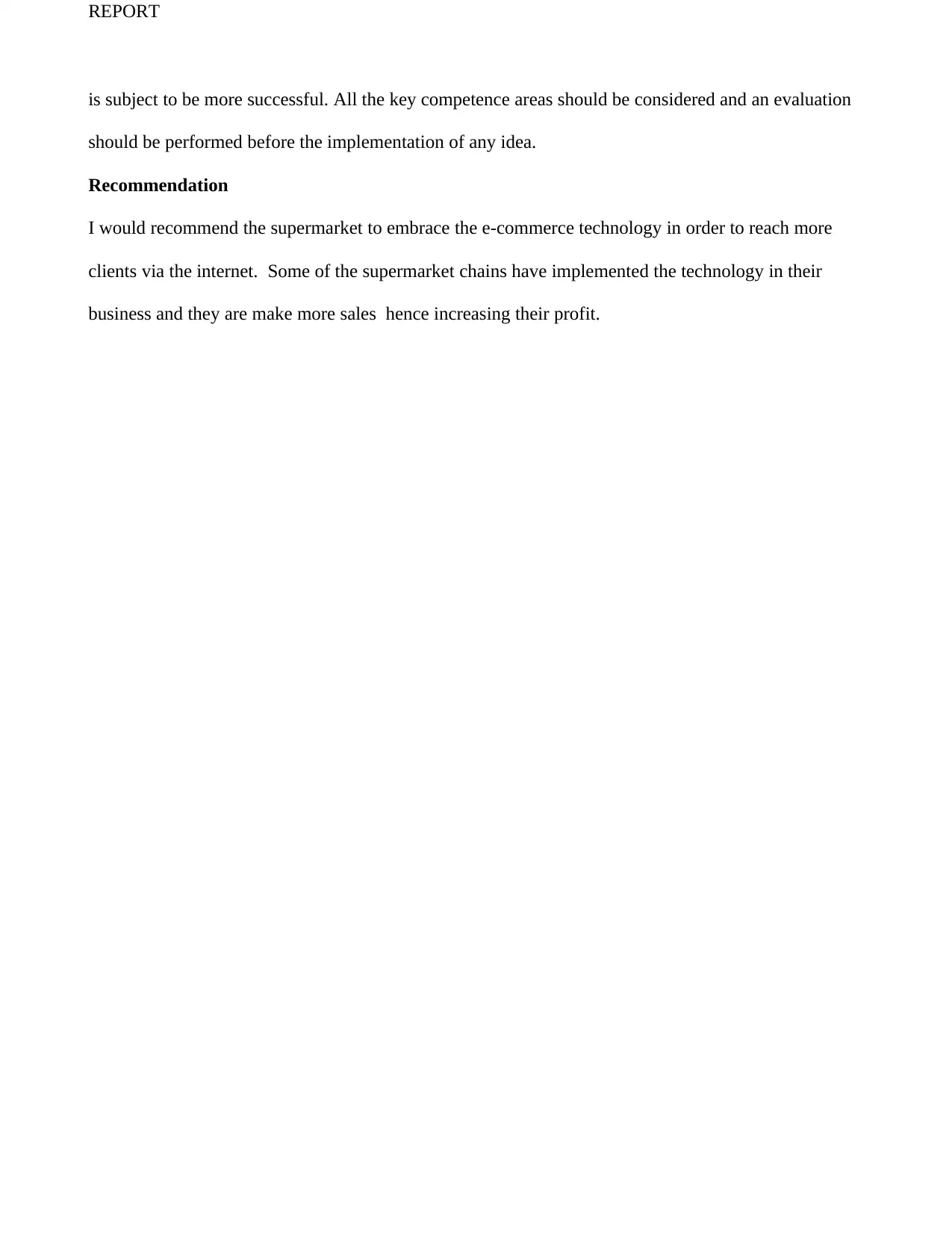
REPORT
is subject to be more successful. All the key competence areas should be considered and an evaluation
should be performed before the implementation of any idea.
Recommendation
I would recommend the supermarket to embrace the e-commerce technology in order to reach more
clients via the internet. Some of the supermarket chains have implemented the technology in their
business and they are make more sales hence increasing their profit.
is subject to be more successful. All the key competence areas should be considered and an evaluation
should be performed before the implementation of any idea.
Recommendation
I would recommend the supermarket to embrace the e-commerce technology in order to reach more
clients via the internet. Some of the supermarket chains have implemented the technology in their
business and they are make more sales hence increasing their profit.
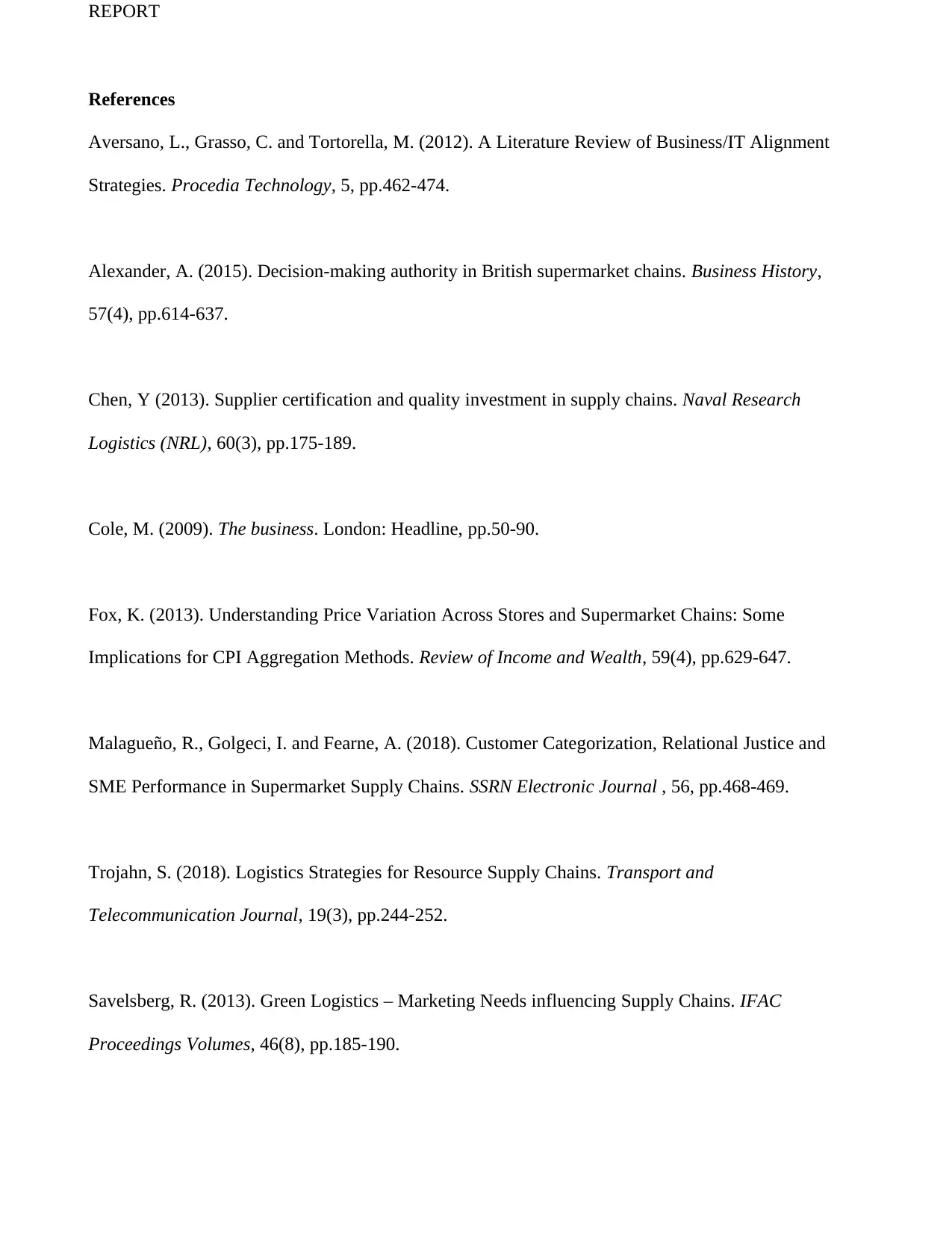
REPORT
References
Aversano, L., Grasso, C. and Tortorella, M. (2012). A Literature Review of Business/IT Alignment
Strategies. Procedia Technology, 5, pp.462-474.
Alexander, A. (2015). Decision-making authority in British supermarket chains. Business History,
57(4), pp.614-637.
Chen, Y (2013). Supplier certification and quality investment in supply chains. Naval Research
Logistics (NRL), 60(3), pp.175-189.
Cole, M. (2009). The business. London: Headline, pp.50-90.
Fox, K. (2013). Understanding Price Variation Across Stores and Supermarket Chains: Some
Implications for CPI Aggregation Methods. Review of Income and Wealth, 59(4), pp.629-647.
Malagueño, R., Golgeci, I. and Fearne, A. (2018). Customer Categorization, Relational Justice and
SME Performance in Supermarket Supply Chains. SSRN Electronic Journal , 56, pp.468-469.
Trojahn, S. (2018). Logistics Strategies for Resource Supply Chains. Transport and
Telecommunication Journal, 19(3), pp.244-252.
Savelsberg, R. (2013). Green Logistics – Marketing Needs influencing Supply Chains. IFAC
Proceedings Volumes, 46(8), pp.185-190.
References
Aversano, L., Grasso, C. and Tortorella, M. (2012). A Literature Review of Business/IT Alignment
Strategies. Procedia Technology, 5, pp.462-474.
Alexander, A. (2015). Decision-making authority in British supermarket chains. Business History,
57(4), pp.614-637.
Chen, Y (2013). Supplier certification and quality investment in supply chains. Naval Research
Logistics (NRL), 60(3), pp.175-189.
Cole, M. (2009). The business. London: Headline, pp.50-90.
Fox, K. (2013). Understanding Price Variation Across Stores and Supermarket Chains: Some
Implications for CPI Aggregation Methods. Review of Income and Wealth, 59(4), pp.629-647.
Malagueño, R., Golgeci, I. and Fearne, A. (2018). Customer Categorization, Relational Justice and
SME Performance in Supermarket Supply Chains. SSRN Electronic Journal , 56, pp.468-469.
Trojahn, S. (2018). Logistics Strategies for Resource Supply Chains. Transport and
Telecommunication Journal, 19(3), pp.244-252.
Savelsberg, R. (2013). Green Logistics – Marketing Needs influencing Supply Chains. IFAC
Proceedings Volumes, 46(8), pp.185-190.
⊘ This is a preview!⊘
Do you want full access?
Subscribe today to unlock all pages.

Trusted by 1+ million students worldwide

REPORT
1 out of 7
Related Documents
Your All-in-One AI-Powered Toolkit for Academic Success.
+13062052269
info@desklib.com
Available 24*7 on WhatsApp / Email
![[object Object]](/_next/static/media/star-bottom.7253800d.svg)
Unlock your academic potential
Copyright © 2020–2025 A2Z Services. All Rights Reserved. Developed and managed by ZUCOL.





